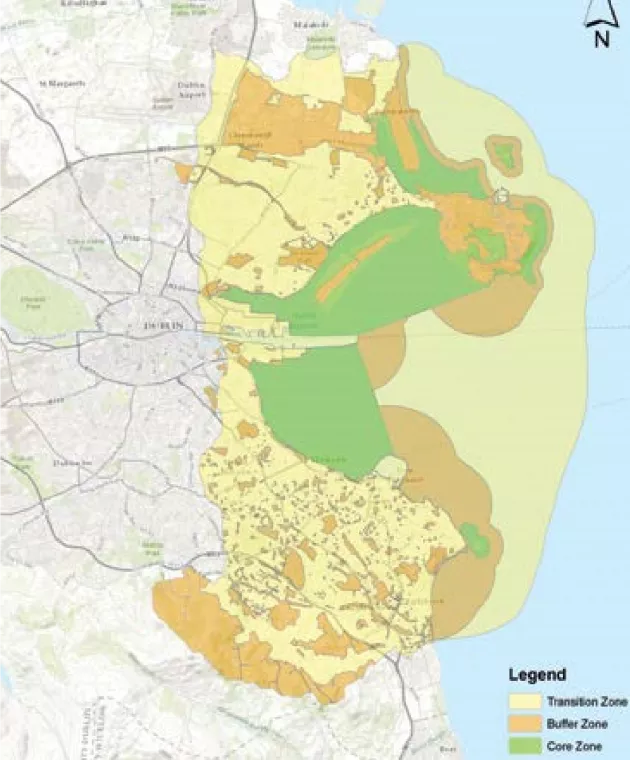4.6.5 Dublin Bay Biosphere
4.6.5 Dublin Bay Biosphere
The designation of Dublin Bay as a Biosphere by UNESCO in June 2015 acknowledges the value of Dublin Bay and its environs to Dublin City. It recognises the biodiversity of the area, as well as the economic, cultural and tourism importance of this biodiversity, and the need for an ecologically sustainable economic model for the Biosphere. It is an important opportunity in the development of Dublin as a ‘Living Bay’ and a green tourism destination.
All Biospheres have three goals:
1. Conservation: promoting the protection of landscapes, habitats, wildlife and cultural values
2. Learning: supporting education and research, for a better understanding of nature and global issues
3. Development: fostering a sustainable economy and society for people living and working in the area
Under the auspices of the Dublin Bay Biosphere Partnership, a five year Conservation Programme, a five year Research Strategy, a three year Business Development Plan and an Education and Awareness Programme will be developed.
The Biosphere is divided into three distinct zones, which are managed in different ways: The core zone consists of protected areas, which are managed for the conservation of landscapes and biodiversity. It includes the Special Areas of Conservation (SACs) and Special Protection Areas (SPAs) at North Bull Island, the Tolka Estuary, North Dublin Bay and South Dublin Bay, among others.
North Bull Island Nature Reserve is managed by Park Services. Work is being undertaken to control Sea-buckthorn on the site. If uncontrolled, this invasive species would spread with the loss of the native dune vegetation, which is protected under
the EU Habitats Directive.
The buffer zone surrounds or adjoins the core zone and is managed to support the core zone. Scientific research, monitoring, training, education and other environmentally sustainable activities are encouraged here. It includes public and private green spaces, such as parks and greenbelts. e.g. Dublin City Council has developed a wildflower meadow in St Anne’s Park, in close proximity to North Bull Island. This meadow contributes to the biodiversity of the area, supporting uncommon plant species such as orchids, and is also used for recreation, environmental education and cultural events.
The transition zone is the outer part of the Biosphere. Sustainable social and economic development is strongly promoted here. It includes residential neighbourhoods, harbours, ports and industrial and commercial areas. e.g. Dublin Port Company, a member of the Dublin Bay Biosphere Partnership, maintains pontoons within the port to provide nesting spaces for Common and Arctic terns, which are protected species under the EU Birds Directive.

Policy
- Dublin City Council will, in association with its partners, assist with achieving the goals of conservation, learning and development of the Dublin Bay UNESCO Biosphere.
Action
- Development of a Biosphere Conservation Programme, Research Strategy, Business Development Plan and Education and Awareness Programme for the Dublin Bay UNESCO Biosphere.